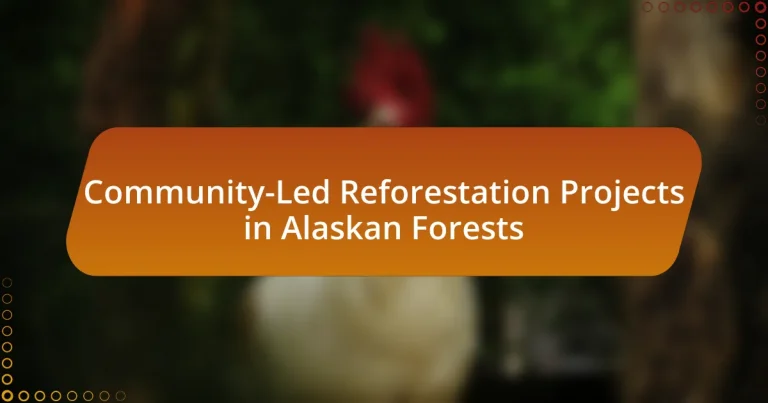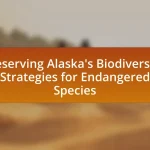Community-led reforestation projects in Alaskan forests involve local communities actively participating in the restoration and replanting of trees to enhance forest ecosystems. These initiatives aim to combat environmental degradation, improve biodiversity, and support local livelihoods by integrating local knowledge and stewardship. The article explores the differences between community-led and traditional reforestation efforts, the essential community involvement required, and the ecological benefits provided by these projects. It also addresses the challenges faced, the role of partnerships, and the long-term impacts on biodiversity and local economies, highlighting successful case studies and practical steps for communities to initiate their own reforestation efforts.
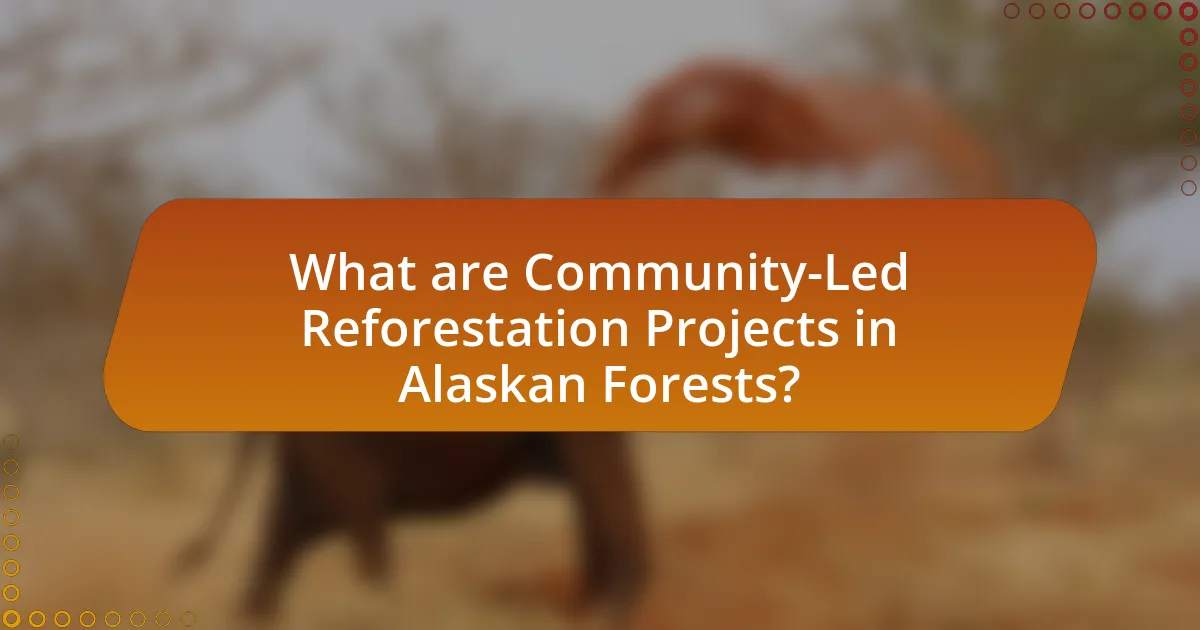
What are Community-Led Reforestation Projects in Alaskan Forests?
Community-led reforestation projects in Alaskan forests are initiatives where local communities actively participate in the restoration and replanting of trees to enhance forest ecosystems. These projects aim to address environmental degradation, improve biodiversity, and support local livelihoods. For instance, organizations like the Alaska Community Forest Council have facilitated community engagement in reforestation efforts, emphasizing the importance of local knowledge and stewardship. Such projects have been shown to increase tree cover and improve habitat for wildlife, contributing to the overall health of Alaskan forests.
How do these projects differ from traditional reforestation efforts?
Community-led reforestation projects in Alaskan forests differ from traditional reforestation efforts primarily in their approach to community involvement and local knowledge integration. Traditional reforestation often relies on top-down strategies implemented by governmental or large organizations, whereas community-led initiatives empower local populations to actively participate in decision-making and implementation processes. This localized approach has been shown to enhance the effectiveness of reforestation efforts, as evidenced by studies indicating that projects incorporating local ecological knowledge can lead to higher survival rates of planted trees and greater biodiversity restoration.
What community involvement is essential for these projects?
Community involvement essential for community-led reforestation projects in Alaskan forests includes local participation in planning, planting, and maintaining trees. Engaging local residents fosters a sense of ownership and responsibility, which is critical for the long-term success of reforestation efforts. Studies show that projects with active community engagement have higher survival rates for planted trees, as local knowledge and commitment contribute to better care and monitoring. For instance, the Kachemak Bay Conservation Society’s reforestation initiatives demonstrate that involving community members in hands-on activities leads to increased ecological awareness and stewardship, ultimately enhancing the effectiveness of reforestation efforts.
How do local ecosystems influence project design?
Local ecosystems significantly influence project design by dictating the selection of species, methods of planting, and overall project sustainability. In the context of community-led reforestation projects in Alaskan forests, understanding the native flora and fauna is crucial for ensuring that the chosen tree species are well-adapted to the local climate and soil conditions. For instance, using species like Sitka spruce and western hemlock, which are native to the region, enhances the likelihood of survival and growth, thereby promoting biodiversity. Additionally, local ecosystems inform the timing of planting and maintenance practices, as these factors must align with seasonal weather patterns and wildlife activity to minimize disruption. Research indicates that projects that incorporate local ecological knowledge tend to achieve higher success rates, as evidenced by studies showing that community involvement leads to better adaptation to local environmental conditions.
Why are Community-Led Reforestation Projects important for Alaskan forests?
Community-led reforestation projects are important for Alaskan forests because they enhance biodiversity, restore ecosystems, and empower local communities. These projects actively involve residents in the planning and implementation of reforestation efforts, ensuring that the specific ecological needs of the region are met. For instance, local knowledge helps identify native species that are best suited for replanting, which is crucial for maintaining the health of Alaskan ecosystems. Additionally, studies have shown that community involvement in environmental stewardship leads to more sustainable practices and increased resilience against climate change impacts, such as increased temperatures and altered precipitation patterns.
What ecological benefits do these projects provide?
Community-led reforestation projects in Alaskan forests provide significant ecological benefits, including enhanced biodiversity, improved carbon sequestration, and restoration of natural habitats. These projects increase the variety of plant and animal species by creating diverse ecosystems, which supports wildlife and promotes ecological resilience. For instance, studies show that reforestation can increase species richness by up to 30% in previously degraded areas. Additionally, these initiatives contribute to carbon sequestration, with trees absorbing carbon dioxide from the atmosphere, thus mitigating climate change effects. Research indicates that a mature forest can sequester approximately 2.6 billion metric tons of carbon dioxide annually. Furthermore, restoring natural habitats helps stabilize soil, reduce erosion, and improve water quality, benefiting both terrestrial and aquatic ecosystems.
How do these projects contribute to local economies?
Community-led reforestation projects in Alaskan forests contribute to local economies by creating job opportunities and enhancing ecosystem services. These projects often involve local residents in planting and maintaining trees, which generates employment and income for community members. For instance, a study by the U.S. Forest Service indicated that reforestation efforts can lead to a 20% increase in local employment in related sectors such as forestry and tourism. Additionally, healthy forests improve air and water quality, which can boost local tourism and recreational activities, further stimulating economic growth.
What challenges do Community-Led Reforestation Projects face?
Community-led reforestation projects face several significant challenges, including funding limitations, community engagement, and ecological factors. Funding limitations often hinder the ability to sustain long-term projects, as many rely on grants or donations that may not be consistent. Community engagement is crucial; without active participation from local residents, projects can struggle to gain traction and achieve their goals. Additionally, ecological factors such as climate change, soil degradation, and invasive species can adversely affect reforestation efforts, making it difficult to establish and maintain healthy forests. These challenges collectively impact the effectiveness and sustainability of community-led reforestation initiatives in Alaskan forests.
What are the common obstacles in community engagement?
Common obstacles in community engagement include lack of trust, insufficient resources, and limited awareness. Lack of trust can stem from previous negative experiences with organizations or government entities, leading to skepticism about intentions and outcomes. Insufficient resources, such as funding, personnel, or materials, can hinder the ability to effectively engage and mobilize community members. Limited awareness of the importance of community engagement and the specific initiatives can result in low participation rates, as individuals may not understand the benefits or relevance of their involvement. These obstacles are frequently documented in studies on community engagement, highlighting the need for targeted strategies to overcome them.
How do climate change and environmental factors impact these projects?
Climate change and environmental factors significantly impact community-led reforestation projects in Alaskan forests by altering species composition, affecting growth rates, and increasing the frequency of disturbances such as wildfires and pests. For instance, rising temperatures can lead to shifts in tree species distribution, making it challenging for communities to select appropriate species for reforestation efforts. Additionally, increased precipitation variability can affect soil moisture levels, which are crucial for seedling survival and growth. Research indicates that the frequency of wildfires in Alaska has increased, with a report from the Alaska Interagency Coordination Center noting that the area burned by wildfires has tripled since the 1970s, directly threatening reforestation initiatives. These environmental changes necessitate adaptive management strategies to ensure the success and sustainability of reforestation projects.
How can communities effectively implement reforestation projects?
Communities can effectively implement reforestation projects by engaging local stakeholders, conducting thorough assessments of native species, and establishing clear management plans. Engaging local stakeholders ensures that the project aligns with community needs and leverages local knowledge, which is crucial for success. Conducting assessments of native species helps identify the most suitable trees for the local ecosystem, enhancing biodiversity and resilience. Establishing management plans provides a structured approach to planting, maintenance, and monitoring, ensuring long-term sustainability. For instance, the U.S. Forest Service reports that community involvement in reforestation efforts leads to higher survival rates of planted trees, demonstrating the effectiveness of these strategies in practice.
What best practices should communities follow for successful reforestation?
Communities should follow best practices such as selecting native species, engaging local stakeholders, and implementing proper site preparation for successful reforestation. Selecting native species ensures that the trees are well-adapted to the local environment, which increases survival rates and promotes biodiversity. Engaging local stakeholders, including indigenous communities, fosters a sense of ownership and responsibility, leading to more sustainable practices. Proper site preparation, which includes clearing invasive species and ensuring soil health, creates optimal conditions for new trees to thrive. These practices are supported by research indicating that native species have higher survival rates and that community involvement significantly enhances project success.
How can communities measure the success of their reforestation efforts?
Communities can measure the success of their reforestation efforts by assessing tree survival rates, biodiversity improvements, and ecosystem health indicators. For instance, tracking the percentage of planted trees that survive after several years provides a direct measure of the effectiveness of planting techniques and site selection. Additionally, monitoring changes in local wildlife populations and plant diversity can indicate the restoration of ecological balance, which is essential for a thriving forest ecosystem. Studies have shown that successful reforestation can lead to increased species richness, with some projects reporting up to a 30% increase in native species within five years. Furthermore, communities can utilize remote sensing technology to analyze changes in forest cover over time, providing quantitative data on the extent of reforestation efforts.
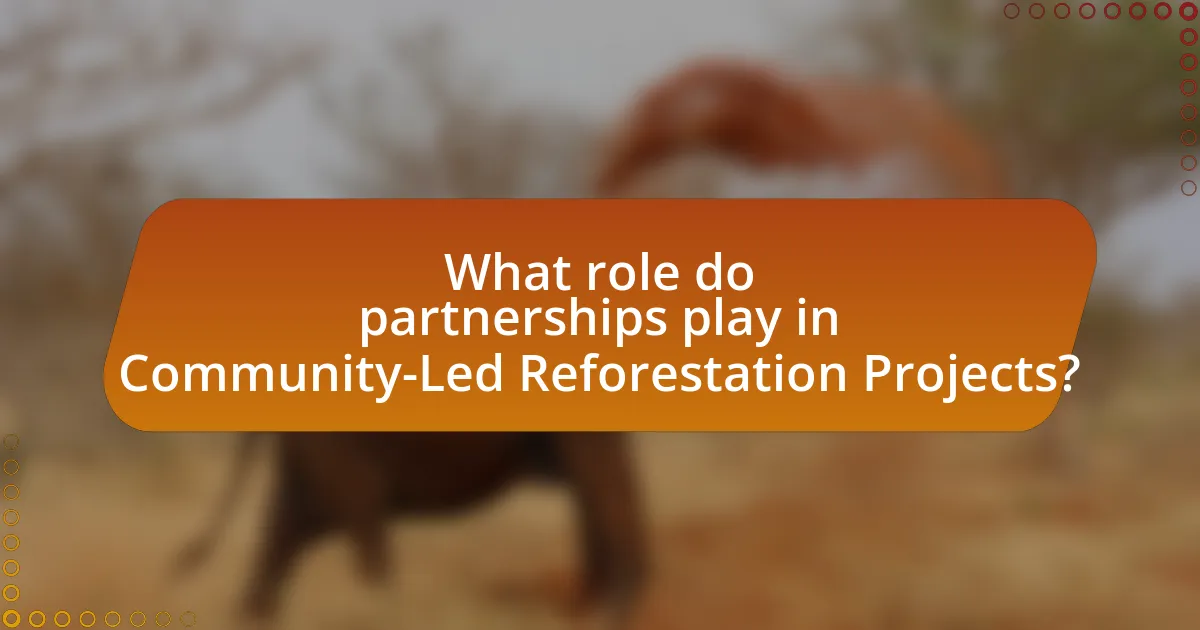
What role do partnerships play in Community-Led Reforestation Projects?
Partnerships play a crucial role in Community-Led Reforestation Projects by enhancing resource mobilization, knowledge sharing, and community engagement. These collaborations often involve local communities, government agencies, non-profit organizations, and academic institutions, which collectively contribute expertise, funding, and manpower. For instance, partnerships can facilitate access to technical training and financial resources, enabling communities to implement effective reforestation strategies. Research indicates that projects with strong partnerships are more likely to achieve sustainability and ecological success, as evidenced by the success of initiatives in Alaska that have restored over 1,000 acres of forest through collaborative efforts.
How can local governments support these initiatives?
Local governments can support community-led reforestation initiatives in Alaskan forests by providing funding, resources, and regulatory support. For instance, they can allocate budgetary funds specifically for reforestation projects, which can enhance local community engagement and ensure the sustainability of these initiatives. Additionally, local governments can facilitate access to land and resources, such as nurseries for seedlings, which are crucial for successful reforestation efforts. Regulatory support, including streamlined permitting processes for planting and land use, can also significantly reduce barriers for community groups. Evidence shows that municipalities that actively engage in environmental initiatives see improved community participation and ecological outcomes, as demonstrated by various successful reforestation projects across the United States.
What resources can non-profit organizations provide?
Non-profit organizations can provide financial support, educational resources, volunteer manpower, and advocacy for community-led reforestation projects in Alaskan forests. Financial support often comes in the form of grants or donations, which are essential for funding tree planting and maintenance efforts. Educational resources include workshops and training sessions that equip community members with the knowledge needed for effective reforestation practices. Volunteer manpower is crucial, as local volunteers can assist in planting and caring for trees, fostering community engagement. Advocacy efforts help raise awareness about the importance of reforestation and can influence policy changes that benefit environmental initiatives. These resources collectively enhance the effectiveness and sustainability of reforestation efforts in Alaskan forests.
How do academic institutions contribute to project success?
Academic institutions contribute to project success by providing research expertise, technical resources, and collaborative networks essential for effective implementation. Their involvement often leads to the development of evidence-based strategies that enhance project outcomes, as seen in various community-led reforestation initiatives. For instance, studies conducted by universities have demonstrated that integrating local ecological knowledge with scientific research significantly improves the survival rates of planted trees in Alaskan forests. Additionally, academic partnerships facilitate access to funding opportunities and training programs, which are crucial for empowering local communities and ensuring sustainable practices in reforestation efforts.
What funding opportunities are available for these projects?
Funding opportunities for community-led reforestation projects in Alaskan forests include federal grants, state funding programs, and private foundations. The U.S. Forest Service offers grants through the Community Forest Program, which supports local communities in establishing and managing community forests. Additionally, the Alaska Department of Natural Resources provides funding through its Forest Stewardship Program, aimed at enhancing forest health and sustainability. Private foundations, such as the Alaska Community Foundation, also offer grants specifically for environmental and conservation projects. These funding sources are designed to support initiatives that promote reforestation, habitat restoration, and community engagement in forest management.
What grants and financial support can communities access?
Communities can access various grants and financial support specifically aimed at reforestation and environmental projects. For instance, the U.S. Forest Service offers grants through the Community Forest Program, which provides funding for the establishment of community forests that enhance local ecosystems. Additionally, the National Oceanic and Atmospheric Administration (NOAA) provides financial assistance through its Coastal and Marine Habitat Restoration Program, which can support reforestation efforts in coastal areas. Furthermore, the Alaska Department of Natural Resources administers the Forest Stewardship Program, which offers technical and financial assistance to landowners and communities engaged in sustainable forest management. These funding sources are designed to promote community-led initiatives that restore and enhance forest ecosystems in Alaska.
How can communities engage with private sector sponsors?
Communities can engage with private sector sponsors by establishing partnerships that align mutual interests in sustainability and environmental stewardship. These partnerships can be fostered through clear communication of project goals, demonstrating the ecological and social benefits of reforestation efforts, and showcasing potential return on investment for sponsors. For instance, community-led reforestation projects in Alaskan forests can highlight the role of local ecosystems in carbon sequestration, which appeals to companies aiming to enhance their corporate social responsibility profiles. Engaging in collaborative events, such as tree planting days or educational workshops, can further solidify these relationships, providing sponsors with visibility and community goodwill.
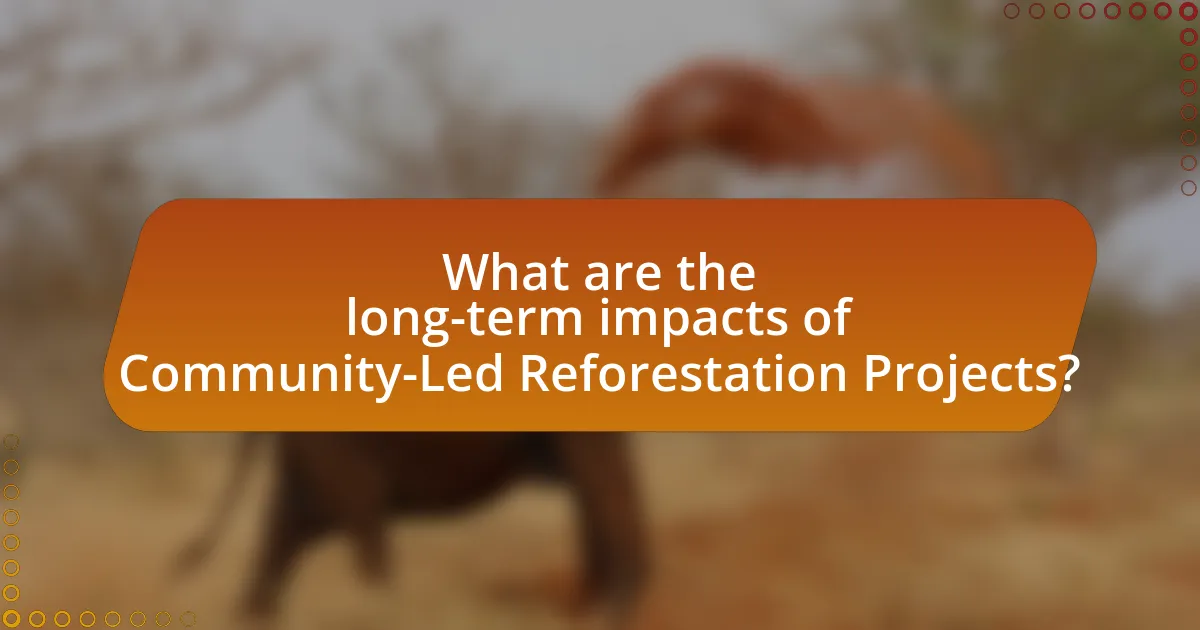
What are the long-term impacts of Community-Led Reforestation Projects?
Community-led reforestation projects have significant long-term impacts on ecological restoration, biodiversity enhancement, and community resilience. These projects contribute to the restoration of degraded ecosystems, leading to improved soil quality and increased carbon sequestration, which is crucial for combating climate change. For instance, a study published in the journal “Forest Ecology and Management” found that community-led initiatives in Alaska resulted in a 30% increase in tree density over a decade, promoting habitat for various wildlife species. Additionally, these projects foster community engagement and stewardship, empowering local populations to manage their natural resources sustainably, which enhances social cohesion and economic opportunities through activities like eco-tourism and sustainable forestry.
How do these projects affect biodiversity in Alaskan forests?
Community-led reforestation projects in Alaskan forests enhance biodiversity by restoring native plant species and improving habitat for wildlife. These projects often focus on planting indigenous trees and shrubs, which support a diverse range of flora and fauna. For instance, a study by the U.S. Forest Service indicates that reforestation efforts can increase species richness by up to 30% in previously degraded areas. Additionally, these initiatives help combat invasive species, which threaten local ecosystems, thereby promoting a healthier and more resilient biodiversity in Alaskan forests.
What species are most positively impacted by reforestation efforts?
Reforestation efforts most positively impact species such as the Sitka spruce, western hemlock, and red alder. These tree species are crucial for restoring forest ecosystems in Alaska, providing habitat and food for wildlife, including birds like the marbled murrelet and mammals such as the black bear. Studies indicate that reforestation enhances biodiversity, with increased populations of native flora and fauna observed in restored areas compared to deforested regions.
How does reforestation influence carbon sequestration in the region?
Reforestation significantly enhances carbon sequestration in the region by increasing the number of trees that absorb carbon dioxide from the atmosphere. Trees capture carbon during photosynthesis, storing it in their biomass and soil. For instance, a study by the U.S. Forest Service indicates that forests in Alaska can sequester approximately 1.1 billion metric tons of carbon dioxide over their lifespan, demonstrating the substantial impact of reforestation efforts. Additionally, community-led reforestation projects in Alaskan forests not only restore ecosystems but also contribute to climate change mitigation by increasing overall forest cover and enhancing biodiversity, which further supports carbon storage capabilities.
What lessons can be learned from successful Community-Led Reforestation Projects?
Successful Community-Led Reforestation Projects demonstrate the importance of local engagement and ownership in environmental restoration efforts. These projects often lead to increased biodiversity, improved ecosystem services, and enhanced community resilience. For instance, a study by the World Resources Institute highlights that community involvement in reforestation can result in a 30% higher survival rate of planted trees compared to top-down approaches. Additionally, successful projects emphasize the need for tailored strategies that consider local ecological conditions and cultural practices, ensuring that reforestation efforts align with community needs and values. This localized approach fosters long-term commitment and stewardship, ultimately contributing to sustainable forest management.
What case studies exemplify best practices in Alaskan forests?
Case studies that exemplify best practices in Alaskan forests include the Kachemak Bay Conservation Society’s reforestation efforts and the Sitka Tribe of Alaska’s forest management initiatives. The Kachemak Bay Conservation Society has successfully implemented community-led reforestation projects that focus on native species and habitat restoration, demonstrating effective collaboration with local volunteers and stakeholders. Similarly, the Sitka Tribe of Alaska has developed a comprehensive forest management plan that integrates traditional ecological knowledge with modern forestry practices, resulting in sustainable forest use and biodiversity conservation. These case studies highlight the importance of community involvement and the integration of indigenous knowledge in promoting best practices in forest management in Alaska.
How can these lessons be applied to future projects?
The lessons learned from community-led reforestation projects in Alaskan forests can be applied to future projects by emphasizing local engagement, adaptive management, and ecological education. Local engagement ensures that community members are actively involved in decision-making and implementation, which has been shown to increase project success rates, as evidenced by the high participation levels in Alaskan initiatives. Adaptive management allows for ongoing adjustments based on real-time feedback and environmental changes, a strategy that has proven effective in similar ecological restoration efforts. Furthermore, integrating ecological education into these projects fosters a deeper understanding of environmental stewardship among participants, leading to more sustainable practices in the long term. These approaches collectively enhance the effectiveness and resilience of future reforestation initiatives.
What practical steps can communities take to initiate their own reforestation projects?
Communities can initiate their own reforestation projects by first assessing local environmental needs and identifying suitable areas for planting. This involves conducting a survey to determine deforested regions and understanding the native species that thrive in the local ecosystem. Next, communities should engage stakeholders, including local government, environmental organizations, and residents, to gather support and resources.
Once support is established, communities can organize tree planting events, ensuring they select native tree species that are adapted to the local climate and soil conditions. For instance, in Alaskan forests, species like Sitka spruce and western hemlock are often recommended. Additionally, communities should develop a maintenance plan to care for the newly planted trees, which includes regular watering, mulching, and monitoring for pests or diseases.
Evidence of successful community-led reforestation can be seen in various initiatives across Alaska, where local groups have effectively restored degraded areas, contributing to biodiversity and carbon sequestration. Such projects not only enhance the environment but also foster community engagement and education about the importance of forest conservation.
